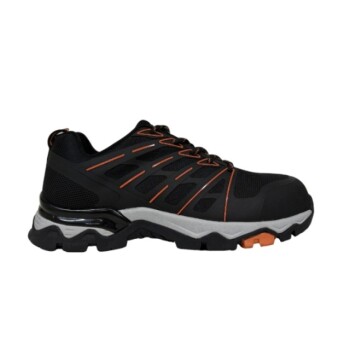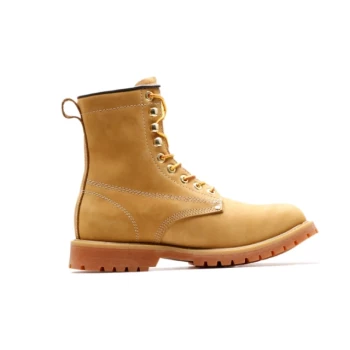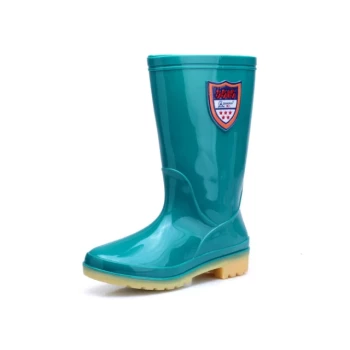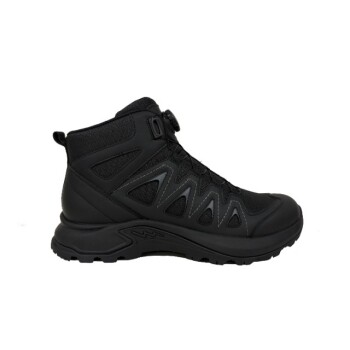At its core, work footwear protects you from electrical hazards by acting as an insulator. These specially designed shoes use non-conductive materials, primarily in the sole, to prevent your body from completing an electrical circuit with the ground. This barrier stops a live electrical current from passing through you in the event of accidental contact.
The critical distinction is understanding the type of electrical protection you need. Electrical Hazard (EH) rated boots are designed to insulate you from a live charge, while Static Dissipative (SD) footwear is designed to safely discharge static buildup to protect sensitive electronics.
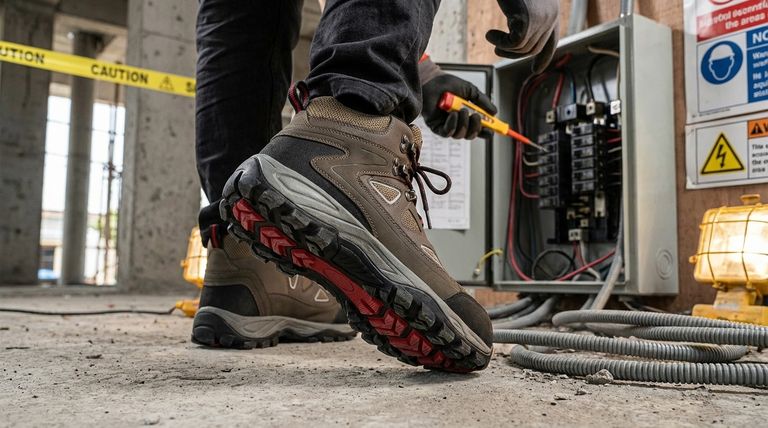
The Core Principle: Breaking the Circuit
To understand how these shoes work, you first need to understand how an electric shock occurs. The principle is simple, yet vital for your safety.
How an Electric Shock Happens
An electric shock requires your body to become part of a complete electrical circuit. This typically happens when you touch a live electrical source and the current flows through your body to the ground, which completes the path.
The Role of Insulation
Electrical Hazard (EH) rated work shoes are built with soles and heels made from non-conductive materials like rubber or polyurethane (PU). This material acts as an insulator, creating a barrier that makes it significantly harder for electricity to flow through you to the ground, effectively breaking the circuit.
Key Types of Electrical Hazard Footwear
Not all safety shoes that deal with electricity do the same thing. The specific rating on the shoe tells you its exact purpose.
Electrical Hazard (EH) Rated Boots
EH-rated footwear is your primary defense against shock from accidental contact with live electrical circuits. These boots are rigorously tested by organizations like ASTM International.
The footwear must be able to withstand the application of 18,000 volts at 60 hertz for one minute with no current flow or leakage current in excess of one milliampere. They are built with non-metallic parts to ensure there are no conductive pathways.
Static Dissipative (SD) Footwear
Static Dissipative (SD) footwear serves a completely different function. It is designed to reduce the buildup of static electricity in your body.
These shoes contain materials that allow static charges to safely bleed off into a grounded floor. This is not for protecting you from live wires; it is for protecting sensitive electronic components that could be damaged by an accidental static discharge.
Understanding the Trade-offs and Limitations
Protective footwear is a critical line of defense, but it is essential to recognize its limitations to remain safe.
EH Protection is a Secondary Defense
EH-rated boots are a secondary source of protection and should not be your primary defense in a hazardous environment. They are designed for accidental contact. Always follow proper safety protocols like lockout/tagout procedures.
The Impact of Wear and Environment
The protective qualities of your boots can be compromised. Excessive wear, deep cuts in the sole, or exposure to moisture can reduce or eliminate their insulating capabilities. Regular inspection is crucial.
Not All Materials Are Equal
For maximum electrical hazard protection, boots with composite safety toes are often preferred over steel toes. While a steel toe can be insulated to pass EH standards, a non-metallic composite toe inherently eliminates one more potential conductor from the boot's construction.
Making the Right Choice for Your Goal
Selecting the correct footwear is not just about compliance; it's about matching the tool to the specific risk you face.
- If your primary focus is personal safety from live circuits (e.g., electrician, utility worker): You must choose footwear with an explicit Electrical Hazard (EH) rating.
- If your primary focus is protecting sensitive equipment from static discharge (e.g., electronics assembly, data center tech): You need Static Dissipative (SD) rated footwear.
- If your primary focus is preventing slips and falls on wet surfaces: Look for a high-traction, slip-resistant outsole, a feature that can and should be combined with the appropriate electrical rating.
Ultimately, understanding the specific electrical risk in your environment is the first step toward ensuring your safety from the ground up.
Summary Table:
| Rating | Primary Function | Ideal For |
|---|---|---|
| Electrical Hazard (EH) | Insulates against live circuits | Electricians, utility workers |
| Static Dissipative (SD) | Safely dissipates static electricity | Electronics assembly, data center technicians |
Need the Right Safety Footwear for Your Team?
As a large-scale manufacturer, 3515 produces a comprehensive range of EH and SD-rated footwear for distributors, brand owners, and bulk clients. Our production capabilities ensure you get durable, compliant boots that protect your workforce from the ground up.
Contact us today to discuss your safety footwear needs and request a quote!
Visual Guide
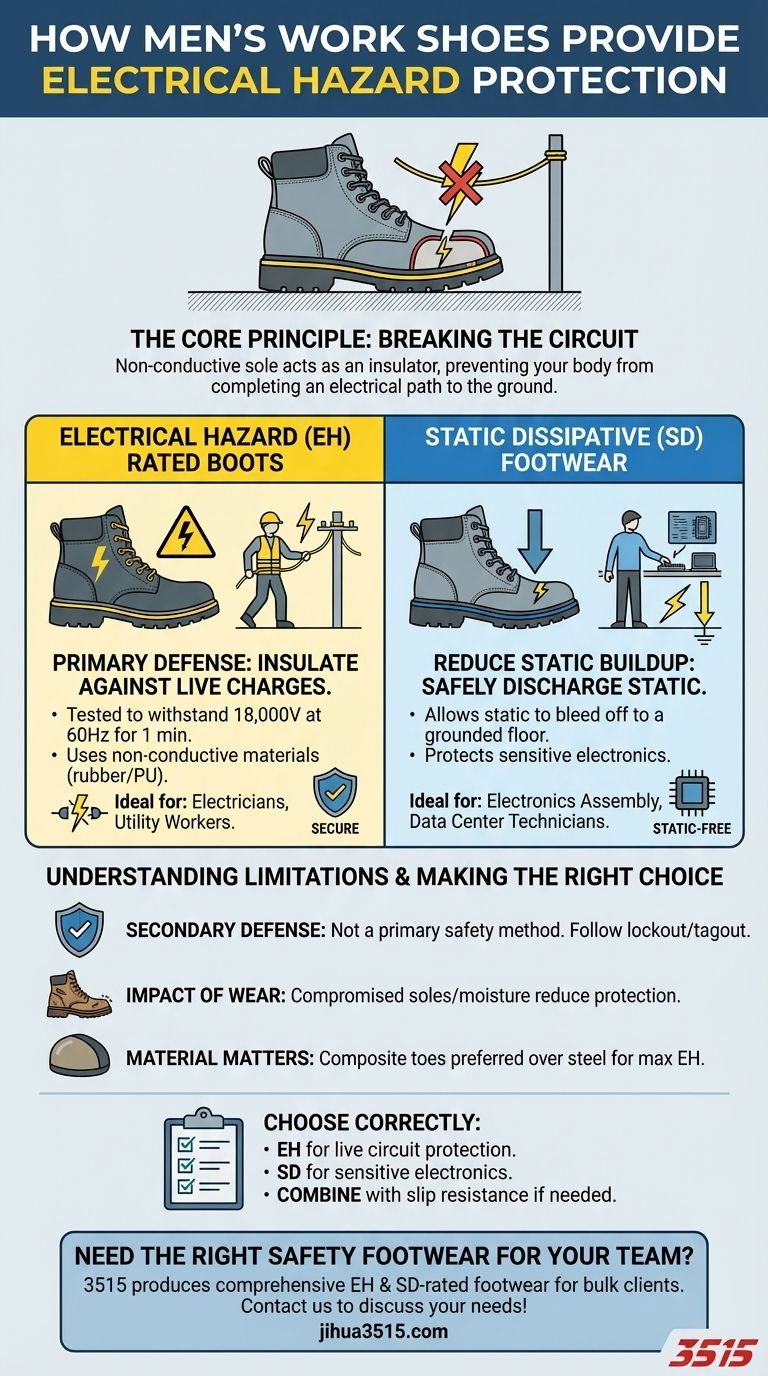
Related Products
- Safety Footwear Wholesale Manufacturer for Custom OEM/ODM Production
- Premium Grain Leather Safety Boots for Bulk Supply
- Premium Wholesale Wheat Nubuck Safety Boot with Rapid Lacing System
- Premium KPU Injection Athletic Style Safety Shoes
- Customizable Anti-Smash Safety Boots for Wholesale & Private Label Manufacturing
People Also Ask
- Is safety-toe as good as steel toe? Choose the Right Protection for Your Job
- What are the differences between steel toe, composite toe, and alloy toe Wellington boots? Choose the Right Safety Toe for Your Job
- How long can you wear safety boots? The Lifespan is Determined by Wear, Not Time
- What do heavy duty boots do? Protect Your Feet in Demanding Work Environments
- Do snake bite boots work? Your Ultimate Guide to Effective Snake Bite Protection



